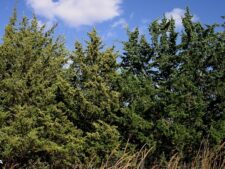
This native evergreen grows to 60 feet tall, with male and female cones on separate trees. Male trees appear more yellowish green (B-left) than the darker green female trees (B-right). See the yellow male cones (C) and light blue female berry-like cones (D) in the close-ups. The leaves are in the form of tiny, overlapping scales. Cedar-apple rust, a common fungus is sometimes seen on cedar in the spring as a gelatinous, orange mass (E). In winter the ripe gall is is brown, up to 2 inches in diameter and hard (F). This fungus also infects apple trees, as reflected by its common name.
Though native, this species readily colonizes open areas such as prairies, where they expand rapidly without disturbances like fire. Historically, Nebraska’s prairies were maintained by frequent anthropogenic fire and cedars typically occurred only in areas that did not burn well such as north aspects. Today, eastern red cedar encroachment in rangelands is a serious ecological and economic issue.
At Fontenelle Forest, cedars are infrequent and are mainly small saplings that are typically top-killed by prescribed fire. At Neale Woods, cedars are common on neighboring properties and may occur in fencerows at property boundaries. Mature cedars at Neale Woods proper are uncommon as they are typically controlled by fire.
Also known as Red Juniper.
The content of NatureSearch is provided by dedicated volunteer Naturalists of Fontenelle Forest who strive to provide the most accurate information available. Contributors of the images retain their copyrights. The point of contact for this page is: Roland Barth.





